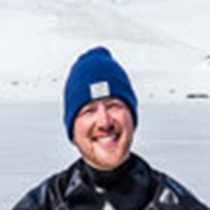The morning began with an early call of whales off the bow. Being extremely surface active, a small group of humpbacks were lunge feeding and practicing the art of bubblenet feeding upon the small baitfish within the water. After a lovely breakfast and the morning stretch class, our guests set off into Williams Cove. With a fair amount of ice grounded by the low tidal swing brought on by the full moon, we were treated to some wonderful photography opportunities. Some took to the trails leading into the forest, while others set out upon kayaks in order to circumnavigate the storied ice sculptures. There were a host of ducks flying overhead, including the Barrow’s goldeneye and harlequin–and even some curious harbor seals dotting about the water.
The afternoon took us through the epic, winding glacial fjord of Tracy Arm. Uncharacteristically, the sky was fully blue overhead, giving us full views of the mountaintops, including the trees and scattered mountain goats upon them. Navigating through the ice-carved rocks, every guest was out on deck while naturalist Elise Lockton pointed out the geology and natural history of what they were beholding. After more turns and waterfalls than one could keep track of, the South Sawyer Glacier came into view, with majesty. Though, it was immediately clear that the amount of ice within the fjord would deny us access. Thus, we chose to visit its icy cousin, Sawyer glacier via our expedition landing craft. Swerving through the icefield, our guests stretched their gaze upwards to catch the rainbows created by the waterfalls. Eventually reaching the glacier’s face, we largely sat in silence in anticipation of a calving event, and calve it did. Shedding pieces of ice that were stories tall, the structures crashed into the water below, earning the name given to them by natives hundreds of years before–white thunder. ‘Twas a glorious end to a fantastic exploration of Alaska’s Inside Passage.







